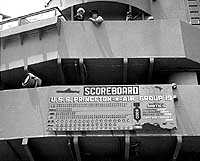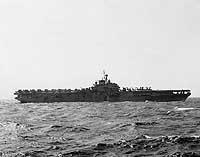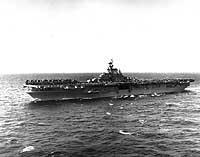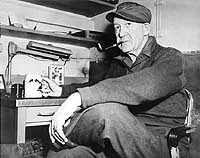
Having temporarily brought Korean War zone fleet carrier levels back up to four ships to meet the crisis of the great Chinese offensive, the U.S. Navy kept three Essex class carriers in the area as the enemy was rolled back and the war stabilized. That allowed at least two to be continuously operational with Task Force 77 in the Sea of Japan, with another not far away at a Japanese port. Occasionally, one could also be spared to cruise off Taiwan as a deterrent to Chinese Communist threats in that area.
By late January 1951, USS Leyte, a reinforcement from the Atlantic Fleet, had just left the Far East after a combat tour of more than three months. Remaining on station were her Pacific Fleet sister ships Philippine Sea , present since the beginning of August; Princeton, an early December arrival; and a very tired Valley Forge , in action with only a brief break since early July 1950. The latter was finally able to go home for a well-deserved overhaul in late March 1951, when the freshly-refitted Boxer arrived to begin her second Korean War tour. In May, the newly-recommissioned Bon Homme Richard came out to relieve Philippine Sea, whose ten-month 1950-51 combat cruise set a Korean War record. Once Princeton left in August 1951 following eight months in the combat area, the addition of more recommissioned ships and an absence of extraordinary crises kept the typical Korean War carrier tour down to a reasonably consistent half-year's duration.
For ships' crews and air group personnel, these deployments were very hard work. During daylight, F9F jet fighters and propeller-driven AD attack planes and F4U figher-bombers were steadily sent out on strike missions, requiring unceasing labor to keep them armed, fueled and maintained. The fuel consumption of the jets and the heavy ordnance loads of the "props" ensured that this labor was vigorous. The geometry of these "axial deck" carriers also meant that planes had to be constantly moved up and down the flight deck to allow launching and recovery. Nightfall rarely brought relief, as that was when oilers and ammunition ships came alongside to replace fuel, bombs, bullets and rockets expended during the day. Night flying added to the workload. It was increasingly in demand as a resourceful enemy employed the cover of darkness to move his supplies and men south toward the front line.
The British carrier presence continued through the period, with HMS Theseus and later HMS Glory providing seaborne air support along Korea's west coast. They were frequently joined by a U.S. Navy escort carrier or the light carrier Bataan, which had air groups of Marine Corps F4U "Corsairs".
This page features miscellaneous images related to the Korean War aircraft carrier operations from 25 January through 30 June 1951, and provides links to further pictorial coverage of this subject.
For additional views of carrier operations during this period,
see:
For access to other views of the stabilization period of
the Korean War, see:
For a precis of our Korean War images, and links to more
comprehensive pictorial coverage of that conflict, see:
| If you want higher resolution reproductions than the Online Library's digital images, see: How to Obtain Photographic Reproductions. |
Click on the small photograph to prompt a larger view of the same image.
|
Photo #: NH 97312 USS Princeton (CV-37) At sea off the coast of Korea with F4U aircraft parked aft and F9F jet fighters forward. The original photograph is dated 8 June 1951. Official U.S. Navy Photograph, from the collections of the Naval Historical Center. Online Image: 81KB; 740 x 605 pixels |
 |
|
Photo #: 80-G-439899 USS Philippine Sea (CV-47) Underway at sea, 9 April 1951, while en route to operating areas off Formosa. Official U.S. Navy Photograph, now in the collections of the National Archives. Online Image: 85KB; 740 x 605 pixels Reproductions of this image may also be available through the National Archives photographic reproduction system. |
 |
|
Photo #: NH 97075 USS Princeton (CV-37) Scoreboard on the carrier's bridge wing, showing the work done by aircraft of Air Group 19 while embarked on Princeton from 5 December 1950 to 29 May 1951. The photograph was released by Commander Naval Forces Far East under date of 7 June 1951. Official U.S. Navy Photograph, from the "All Hands" collection at the Naval Historical Center. Online Image: 125KB; 740 x 620 pixels |
 |
|
Photo #: NH 97045 USS Princeton (CV-37) Awards ceremony on the flight deck, in which 31 Naval Aviators of Air Group 19 received Air Medals, and two more received Gold Stars in lieu of a third Air Medal, circa May 1951. The medals were presented by Captain William O. Gallery, the carrier's Commanding Officer. They were awarded "For meritorius achievement in aerial flights in attacks on hostile North Korean and Chinese Communist forces, while upholding policies of the United Nations Security Council". The ceremonies included a fly past salute by Air Group 19 fighter planes. Note still and motion picture photographers at work, and HO3S helicopter parked aft. Also flight deck barrier rigged, but retracted, in lower part of the image. This photograph was released by Commander, Naval Forces Far East on 16 May 1951. Official U.S. Navy Photograph, from the "All Hands" collection at the Naval Historical Center. Online Image: 171KB; 740 x 625 pixels Note: The original print is somewhat disfigured by the emulsion having been pulled off in the upper left. |
 |
|
Photo #: 80-G-439889 Captain John Ford, USNR Has coffee in the photo lab on board USS Philippine Sea (CV-47), during the filming his motion picture "This is Korea", off the Korean coast on 8 January 1951. A professional film director in civilian life, he also made movies for and about the Navy while serving on active duty. Official U.S. Navy Photograph, now in the collections of the National Archives. Online Image: 109KB; 790 x 610 pixels Reproductions of this image may also be available through the National Archives photographic reproduction system. |
 |
|
Photo #: 80-G-439891 USS Philippine Sea (CV-47) Lieutenant(Junior Grade) Samuel G. Gorsline, of Attack Squadron 115 (VA-115), stands behind a motion picture camera, with Chief Photographer Charles R. Bohuy beside him, during the filming of footage used in John Ford's motion picture "This is Korea", 26 January 1951. A Grumman F9F-2 "Panther" (Bureau Number 12345x) is parked behind them. Official U.S. Navy Photograph, now in the collections of the National Archives. Online Image: 96KB; 585 x 765 pixels Reproductions of this image may also be available through the National Archives photographic reproduction system. |
 |
|
Photo #: 80-G-439892 Lieutenant Commander Mark Armistead, USNR Seated in the after cockpit of a Douglas AD-4N "Skyraider" attack plane, on board USS Philippine Sea (CV-47), during the filming of motion picture footage used in John Ford's "This is Korea", off the Korean coast on 27 January 1951. Note: camera; flight gear and inflatable life vest worn by LCdr. Armistead; and paper bag containing a strong admonition encouraging its use by those afflicted with airsickness. Official U.S. Navy Photograph, now in the collections of the National Archives. Online Image: 92KB; 590 x 765 pixels Reproductions of this image may also be available through the National Archives photographic reproduction system. |
 |
For additional views of carrier operations during the period
25 January - 30 June 1951, see:
For access to other views of the stabilization period of
the Korean War, see:
For a precis of our Korean War images, and links to more
comprehensive pictorial coverage of that conflict, see:
| If you want higher resolution reproductions than the Online Library's digital images, see: How to Obtain Photographic Reproductions. |
24 September 2000